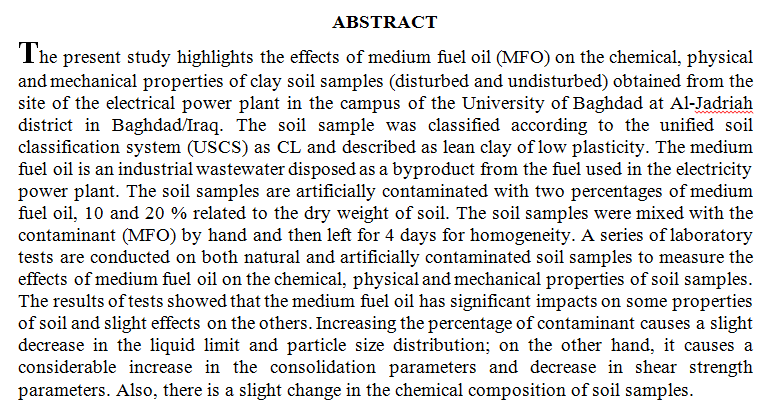
Cr2O3 thin films have been prepared by spray pyrolysis on a glass substrate. Absorbance and transmittance spectra were recorded in the wavelength range (300-900) nm before and after annealing. The effects of annealing temperature on absorption coefficient, refractive index, extinction coefficient, real and imaginary parts of dielectric constant and optical conductivity were expected. It was found that all these parameters increase as the annealing temperature increased to 550°C.
Copper tin sulfide (Cu2SnS3) thin films have been grown on glass
substrate with different thicknesses (500, 750 and 1000) nm by flash
thermal evaporation method after prepare its alloy from their
elements with high purity. The as-deposited films were annealed at
473 K for 1h. Compositional analysis was done using Energy
dispersive spectroscopy (EDS). The microstructure of CTS powder
examined by SEM and found that the large crystal grains are shown
clearly in images. XRD investigation revealed that the alloy was
polycrystalline nature and has cubic structure with preferred
orientation along (111) plane, while as deposited films of different
thickness have amorphous structure and converted to polycrystalline
A laboratory experiment was carried out and repeated at field of College of Agricultural Engineering Sciences, University of Baghdad in 2017. First factor was three cultivars of lupine 'Giza-1', 'Giza-2' and 'Hamburg'. Second factor was three seed weights (lower weight, medium weight and higher weight) which was following the cultivars factor. Nested design was used. Results showed supremacy of 'Giza-1' cultivar significantly and gave higher germination ratio, radical length, seedling dry weight, seedling vigour index, field emergence ratio, plant height and number of leaves per plant. The treatment ('Giza-1'×higher seed weight) was supremacy significantly and gave higher germination ratio, radical length, plumule length, and seedling vigo
... Show More (2)
(2)
 (2)
(2)
Superconducting thin films of Bi1.6Pb0.4Sr2Ca2Cu2.2Zn0.8O10 system were prepared by depositing the film onto silicon (111) substrate by pulsed laser deposition. Annealing treatment and superconducting properties were investigated by XRD and four probe resistivity measurement. The analysis reveals the evolution of the minor phase of the films 2212 phase to 2223 phase, when the film was annealed at 820 °C. Also the films have superconducting behavior with transition temperature ≥90K.
A 3D geological model is an essential step to reveal reservoir heterogeneity and reservoir properties distribution. In the present study, a three-dimensional geological model for the Mishrif reservoir was built based on data obtained from seven wells and core data. The methodology includes building a 3D grid and populating it with petrophysical properties such as (facies, porosity, water saturation, and net to gross ratio). The structural model was built based on a base contour map obtained from 2D seismic interpretation along with well tops from seven wells. A simple grid method was used to build the structural framework with 234x278x91 grid cells in the X, Y, and Z directions, respectively, with lengths equal to 150 meters. The to
... Show MoreAbstract
This study came to clarify the redemption in terms of being a method and a subject of knowledge that has its causes, controls, etiquette and scientific implications for Muslim scholars.
The science of redemption has a historical extension, starting from the era of the Companions - may God be pleased with them - and through the stages of codification and classification of works in an effort to document it and diversify its methods at the inductive, analytical, critical and argumentative levels, and to determine its causes and from the completion of the research conclude it with evidence of its scientific effects because it is a science that enriched the Islamic library in general, and hadith in particular.
This paper presents a comparative study between different oil production enhancement scenarios in the Saadi tight oil reservoir located in the Halfaya Iraqi oil field. The reservoir exhibits poor petrophysical characteristics, including medium pore size, low permeability (reaching zero in some areas), and high porosity of up to 25%. Previous stimulation techniques such as acid fracturing and matrix acidizing have yielded low oil production in this reservoir. Therefore, the feasibility of hydraulic fracturing stimulation and/or horizontal well drilling scenarios was assessed to increase the production rate. While horizontal drilling and hydraulic fracturing can improve well performance, they come with high costs, often accounting for up t
... Show MoreBackground: The displacement of artificial teeth during complete denture construction presents major processing errors in the occlusal vertical dimension which were verified at the previous trial denture stage. The aim of this study was to assess the effect of delay in processing after final flask closure and tension application on the vertical acrylic and porcelain teeth displacement of complete dentures constructed from heat cured acrylic and the results were compared with the conventional processing method. Materials and methods: forty samples of identical maxillary complete dentures were constructed from heat polymerized acrylic resin. These samples were subdivided into the following experimental subgroups in which each subgroup contai
... Show MoreThis work describes an experimental setup to evaluate the photodynamictoxicity of 650 nm diode laser and 532 nm Frequency-doubled Q-Switched Nd:YAG laser on the growth of Candida albicans as well as the potential fungicidal effect when combining the laser irradiation with specific photosensitizers namely methylene blue, toluidine blue, acridine orange and safranin O. In this study the findings showed that the number of colony-forming units per millilitre (CFU/ml) of C. albicans decreased with increasing exposure time. In particular in the case of the frequency doubled Nd:YAG laser combined with safranin O, the best lethal effect occurred at 11 minutes exposure time with 2.26 J/cm² energy density (89.18% reduction) in comparison with the
... Show More